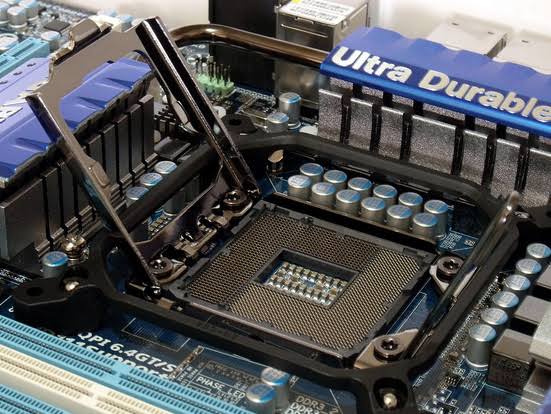
In computer hardware, a CPU socket or CPU slot comprises one or more mechanical components providing mechanical and electrical connections between a microprocessor and a printed circuit board (PCB). This allows for placing and replacing the central processing unit (CPU) without soldering.
Common sockets have retention clips that apply a constant force, which must be overcome when a device is inserted. For chips with a large number of pins, either zero insertion force (ZIF) sockets or land grid array (LGA) sockets are used instead. These designs apply a compression force once either a handle (for ZIF type) or a surface plate (LGA type) is put into place. This provides superior mechanical retention while avoiding the risk of bending pins when inserting the chip into the socket.
CPU sockets are used on the motherboard in desktop and server computers. As they allow easy swapping of components, they are also used for prototyping new circuits. Laptops typically use surface-mount CPUs, which take up less space on the motherboard than a socketed part.
What is processor?A central processing unit (CPU) is the electronic circuitry within a computer that carries out the instructions of a computer program by performing the basic arithmetic, logical, control and input/output (I/O) operations specified by the instructions. The computer industry has used the term "central processing unit" at least since the early 1960s.[1] Traditionally, the term "CPU" refers to a processor, more specifically to its processing unit and control unit (CU), distinguishing these core elements of a computer from external components such as main memory and I/O circuitry.
The form, design and implementation of CPUs have changed over the course of their history, but their fundamental operation remains almost unchanged. Principal components of a CPU include the arithmetic logic unit (ALU) that performs arithmetic and logic operations, processor registers that supply operands to the ALU and store the results of ALU operations, and a control unit that orchestrates the fetching (from memory) and execution of instructions by directing the coordinated operations of the ALU, registers and other components.
Most modern CPUs are microprocessors, meaning they are contained on a single integrated circuit (IC) chip. An IC that contains a CPU may also contain memory, peripheral interfaces, and other components of a computer; such integrated devices are variously called microcontrollers or systems on a chip (SoC). Some computers employ a multi-core processor, which is a single chip containing two or more CPUs called "cores"; in that context, one can speak of such single chips as "sockets".[3] Array processors or vector processors have multiple processors that operate in parallel, with no unit considered central. There also exists the concept of virtual CPUs which are an abstraction of dynamical aggregated computational resources.